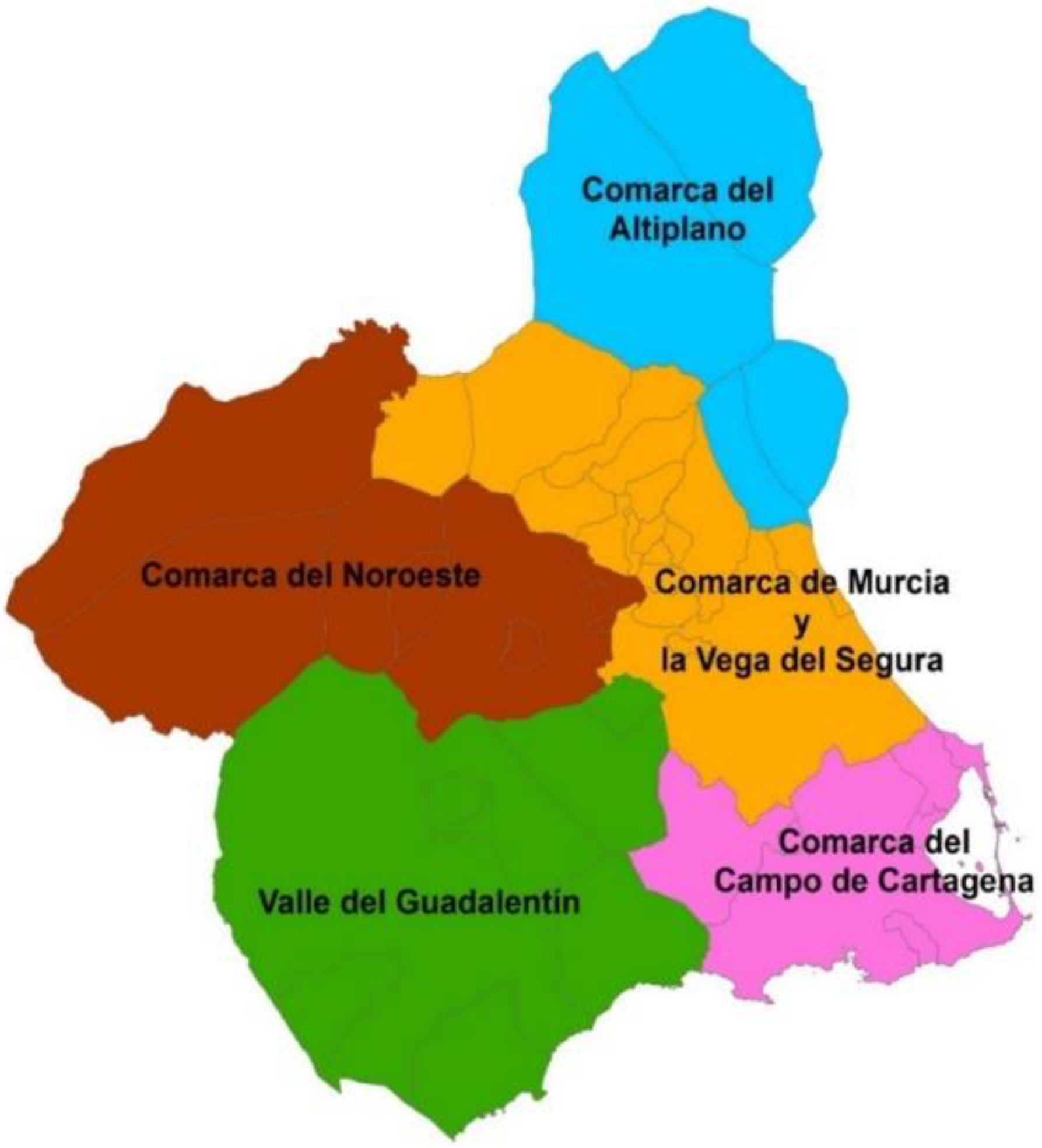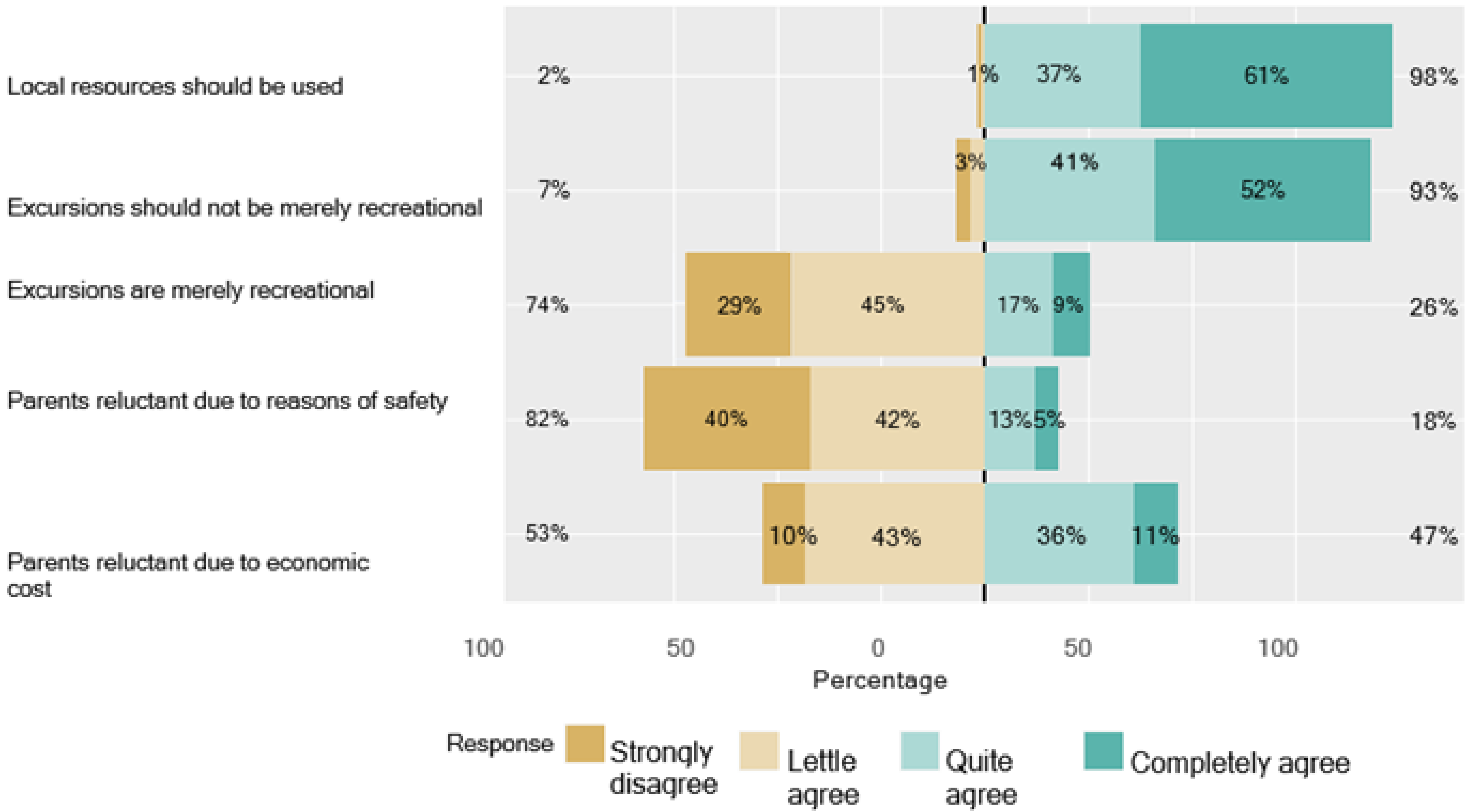School Trips and Local Heritage as a Resource in Primary Education: Teachers’ Perceptions
Abstract
1. Introduction
2. Materials and Methods
2.1. Approach and Design
2.2. Context and Participants
2.3. Data Collection: Tools and Procedures
3. Results
4. Discussion and Conclusions
- The teacher is responsible for choosing which educational trips will be carried out;
- Curricular contents are always worked on during educational trips;
- Educational trips are prepared beforehand, and classwork is done after the field trip;
- The objectives include going out to discover the local area and its heritage;
- Field trips should not be merely recreational.
- The heritage resources of the area around the schools and towns/cities should be used.
Author Contributions
Funding
Institutional Review Board Statement
Informed Consent Statement
Data Availability Statement
Conflicts of Interest
References
- Corrochano, D.; Gómez-Gonçalves, A.; Sánchez-Barbero, B.; Martín-Pastor, E. Field trips and other teaching resources in natural and social sciences: Educational implications from past experiences in Spanish primary schools. Hist. Educ. Child. Lit. 2019, 14, 779–798. [Google Scholar]
- Julien, M.P.; Chalmeau, R. Field trips in french schools: Teacher practices and motivations. Int. J. Sci. Educ. 2022, 44, 896–920. [Google Scholar] [CrossRef]
- Sousa Fernandes, S.A.; García Monteagudo, D.; Souto González, X.M. Educación geográfica y las salidas de campo como estrategia didáctica: Un estudio comparativo desde el geoforo. Biblio 3W 2016, XXI, 1–21. [Google Scholar]
- Fuller, I.; Edmondson, S.; France, D.; Higgitt, D.; Ratinen, I. International perspectives on the effectiveness of geography fieldwork for learning. J. Geogr. High. Educ. 2006, 1, 89–101. [Google Scholar] [CrossRef]
- Morote Seguido, A.F. Las salidas de campo en españa como recurso didáctico para la enseñanza de la geografía. Una revisión bibliográfica. Geographicalia 2019, 71, 27–49. [Google Scholar] [CrossRef]
- Boulahrouz, M. Salidas de campo y educación para el desarrollo sostenible. Una propuesta para la participación juvenil usando el storytelling digital. EDMETIC 2021, 10, 184–201. [Google Scholar] [CrossRef]
- García-Ceballos, S.; Aso, B.; Navarro-Neri, I.; Rivero, M.P. La Sostenibilidad del patrimonio en la formación de Los futuros docentes de educación primaria: Compromiso y práctica futura. RIFOP 2021, 96, 87–108. [Google Scholar] [CrossRef]
- Vilarrasa, A. Salir del aula. Reapropiarse del contexto. Íber 2023, 36, 13–25. [Google Scholar]
- Estepa, J. El patrimonio en la didáctica de la ciencias sociales: Obstáculos y propuestas para su tratamiento en el aula. Íber 2011, 27, 93–105. [Google Scholar]
- González, N.; Pagès, J. Algunas propuestas para mejorar el uso didáctico del patrimonio cultural en el proceso de enseñanza-aprendizaje de la historia. In Journées D’etudes Didactiques de la Géographie et de L’histoire; Universidad Autónoma de Barcelona: Barcelona, Spain, 2005; pp. 3–7. [Google Scholar]
- Cuenca, J.M. El Papel del Patrimonio en los Centros Educativos: Hacia la Socialización Patrimonial. Junta de Extemadura. Tejuelo 2013, 19, 76–96. [Google Scholar]
- United Nations (UN) General Assembly. Transforming our world: The 2030 Agenda for Sustainable Development. 2015. Available online: www.refworld.org/docid/57b6e3e44.html (accessed on 2 October 2022).
- ICOM. Available online: https://icom.museum/es/news/resoluciones-aprobadas-por-la-34a-asamblea-general-del-icom/ (accessed on 14 November 2022).
- Agudo, J. Reflexión Sobre Nuestro Patrimonio Etnológico. Pensando en Andalucía. In Patrimonio Histórico y Desarrollo Territorial; Castillo, J., Cejudo, E., Ortega, A., Eds.; Unviversidad Internacional de Sevilla: Sevilla, Spain, 2009. [Google Scholar]
- Bermúdez, A.; Vianney, J.; Giralt, A. Intervención en el Patrimonio Cultural. Creación y Gestión de Proyectos; Síntesis: Madrid, Spain, 2004. [Google Scholar]
- Calaf, R. Didáctica del Patrimonio: Epistemología, Metodología y Estudio de Casos; Trea: Gijón, Spain, 2009. [Google Scholar]
- Estepa, J.; Cuenca, J.M.; Martín, M. La enseñanza de las sociedades actuales e históricas a través del patrimonio. Íber 2009, 79, 33–40. [Google Scholar]
- Domínguez, A.; López Facal, R. Patrimonio, paisaje y educación: Formación inicial del profesorado y educación cívica del alumnado de Primaria. CLIO 2014, 40, 24. [Google Scholar]
- Estepa, J.; Cuenca, J.M.; Martín, M. Enseñar y aprender las sociedades actuales e históricas a través del patrimonio en la educación primaria. In Pensar Históricamente en Tiempos de Globalización. I Congreso Internacional Sobre Enseñanza de la Historia. Investigación y Buenas Prácticas en Educación Patrimonial Entre la Escuela y el Museo. Territorio, Emociones y Ciudadanía; López Facal, R., Velasco, L., Santidrián, V., Armas, X.A., Eds.; Universidad de Santiago de Compostela: Santiago, Spain, 2011; pp. 243–254. [Google Scholar]
- Estepa, J.; Cuenca, J.M.; Martín Cáceres, M.J. Líneas Futuras de Trabajo Desde el Proyecto Epitec: Patrimonios Controversiales Para una Educación Ecosocial de la Ciudadanía; Cuenca, J.M., Estepa, J., Eds.; Trea: Gijón, Spain, 2021; pp. 485–496. [Google Scholar]
- Mateo, J. La Investigación ex Post-facto. In Metodología de la Investigación Educativa; Bisquerra, R., Ed.; Editorial La Muralla: Madrid, Spain, 2014; pp. 195–230. [Google Scholar]
- Martín Marín, B. Investigación descriptiva. In Métodos de Investigación y Análisis de Datos en Ciencias Sociales y de la Salud; Cubo, S., Martín Marín, B., Ramos, J.L., Eds.; Ediciones Pirámide: Madrid, Spain, 2011; pp. 373–385. [Google Scholar]
- Matas, A. Introducción a la Investigación en Ciencias de la Educación; Bubok Publishing S.L: Madrid, Spain, 2011; pp. 52–58. [Google Scholar]
- Serrano Pastor, F.J. El cuestionario en la investigación en ciencias sociales. In Proceedings of the Seminario de la Asociación Extremeña de Ciencias Matemáticas, Badajoz, Spain, 4–6 September 2008. [Google Scholar]
- Casas, J.; García, J.; González, F. Guía técnica para la construcción de cuestionarios. Odiseo Rev. Electr. Pedag. 2006, 3, 6. [Google Scholar]
- Ruiz, J.; Izquierdo, M.; Piñera, J.T. El cuestionario estructurado como herramienta básica para la evaluación de las instituciones documentales. In Proceedings of the VI Jornadas Españolas de Documentación, Valencia, Spain, 29–31 October 1998. [Google Scholar]
- Tymms, P. Questionnaires. Research Methods and Methodologies in Education; Arthur, J., Waring, M., Coe, R., Hedges, L.V., Eds.; Sage Publications Ltd.: Thousand Oaks, CA, USA, 2012; pp. 231–240. Available online: https://www.researchgate.net/publication/336149706_Research_Methods_and_Methodologies_in_Education_SECOND_EDITION (accessed on 1 October 2022).
- Cubo, S. Métodos de Investigación y Análisis de Datos en Ciencias Sociales y de la Salud; Cubo, S., Martin Marin, B., Ramos, J.L., Eds.; Pirámide: Madrid, Spain, 2011. [Google Scholar]
- Mateo, J.; Martínez Olmo, F. La Evaluación Alternativa de los Aprendizajes; Octaedro: Barcelona, Spain, 2008. [Google Scholar]
- Maurandi, A.; Del Río, L.; Balsalčobre, C. Fundamentos Estadísticos para Investigación. Introducción a R.; Bubok Publishing S.L.: Madrid, Spain, 2013. [Google Scholar]
- Maurandi López, A.; González Vidal, A. (Eds.) Análisis de Datos y Métodos Estadísticos con R.; EDITUM: Murcia, Spain, 2022. [Google Scholar] [CrossRef]
- Dobón, J.; Fonolleda, M. Diseño de salidas escolares de calidad. Cuad. Pedag. 2021, 521, 48–56. [Google Scholar]
- Saribas, S.; Coskun, N. Local environmental experiences of middle school students in art education in Turkey. Education 3–13 2022. [Google Scholar] [CrossRef]
- Menazel Basil, H. Upper Primary Level History Teachers’ Attitudes toward the Use of School Field Trips as an Educational Aid throughout Schools in Irbid First Education Directorate. J. Educ. Praet. 2015, 6, 7–16. [Google Scholar]
- DeWitt, J.; Storksdieck, M. A Short Review of School Field Trips: Key Findings from the Past and Implications for the Future. Visit. Stud. 2008, 11, 181–197. [Google Scholar] [CrossRef]
- John, H. Falk. Field trips: A look at environmental effects on learning. J. Biol. Educ. 1983, 17, 137–142. [Google Scholar] [CrossRef]
- Fernández-Portela, J. La salida de campo como recurso didáctico para conocer el espacio geográfico: El caso de la ciudad de Valladolid y de Soria. Didáctica Geográfica 2017, 18, 91–109. [Google Scholar]
- García Gómez, S.; Cabanillas, M. Escolares sin excursiones: ¿una consecuencia de la crisis económica? EDUCAR 2016, 52, 33–50. [Google Scholar] [CrossRef]
- Escribano-Miralles, A.; Serrano-Pastor, F.-J.; Miralles-Martínez, P. Perceptions of educational agents regarding the use of school visits to museums for the teaching of history. Sustainability 2021, 13, 4915. [Google Scholar] [CrossRef]
- Lavado, P.J. ¿Qué es el patrimonio? Educar para conservar y proteger. In El Patrimonio y la Didáctica de las Ciencias Sociales; Ballesteros, E., Fernández, C., Molina, J.A., Moreno, P., Eds.; Asociación de Profesores de Didáctica de las CCSS: Cuenca, Spain, 2023; pp. 21–30. [Google Scholar]



| Districts | Inhabitants | Pupils in 5th and 6th Years of Primary Education | Data-Producing Sample of Families | |||
|---|---|---|---|---|---|---|
| N | % | N | % | N | % | |
| Vega del Segura | 735,621 | 50.13 | 16,807 | 49.71 | 1123 | 58.1 |
| Campo Cartagena | 358,485 | 24.23 | 8613 | 25.48 | 431 | 22.3 |
| Altiplano | 75,745 | 5.16 | 1720 | 5.09 | 99 | 5.1 |
| Noroeste | 84,448 | 5.76 | 1883 | 5.57 | 76 | 3.9 |
| Guadalentín | 212,989 | 14.52 | 4784 | 14.15 | 203 | 10.5 |
| Min | Max | AV | (SD) | Q1 | Me | Q3 | n | |
|---|---|---|---|---|---|---|---|---|
| Age | 24.0 | 64.0 | 44.7 | (11.2) | 34.2 | 44.0 | 55.8 | 110 |
| Experience | 1.0 | 42 | 18.8 | (12.1) | 8.0 | 15.0 | 30.0 | 107.0 |
| Questionnaire | Predictor Variables | Criterion Variables |
|---|---|---|
| CUELX-M |
|
|
| Mark only One Option According to Your Opinion in Relation to the Following Statements: 1 “Completely Disagree,” 2 “Disagree,” 3 “Agree” and 4 “Completely Agree” |
|---|
|
|
|
|
|
|
|
|
|
|
|
| Min | Max | AV | (SD) | Q1 | Me | Q3 | |
|---|---|---|---|---|---|---|---|
| Social sciences teacher chooses educational trips | 1 | 4 | 3.3 | (0.80) | 3 | 3 | 4 |
| Contents worked on during educational trips | 1 | 4 | 3.3 | (0.68) | 3 | 3 | 4 |
| Work is carried out before and after | 1 | 4 | 3.1 | (0.77) | 3 | 3 | 4 |
| Objective of educational trips: learning about the local environment | 1 | 4 | 3.2 | (0.72) | 3 | 3 | 4 |
| Objective of educational trips: learning about heritage | 1 | 4 | 3.2 | (0.77) | 3 | 3 | 4 |
Disclaimer/Publisher’s Note: The statements, opinions and data contained in all publications are solely those of the individual author(s) and contributor(s) and not of MDPI and/or the editor(s). MDPI and/or the editor(s) disclaim responsibility for any injury to people or property resulting from any ideas, methods, instructions or products referred to in the content. |
© 2023 by the authors. Licensee MDPI, Basel, Switzerland. This article is an open access article distributed under the terms and conditions of the Creative Commons Attribution (CC BY) license (https://creativecommons.org/licenses/by/4.0/).
Share and Cite
Sánchez-Fuster, M.C.; Miralles-Martínez, P.; Serrano-Pastor, F.-J. School Trips and Local Heritage as a Resource in Primary Education: Teachers’ Perceptions. Sustainability 2023, 15, 7964. https://doi.org/10.3390/su15107964
Sánchez-Fuster MC, Miralles-Martínez P, Serrano-Pastor F-J. School Trips and Local Heritage as a Resource in Primary Education: Teachers’ Perceptions. Sustainability. 2023; 15(10):7964. https://doi.org/10.3390/su15107964
Chicago/Turabian StyleSánchez-Fuster, Mª Carmen, Pedro Miralles-Martínez, and Francisca-José Serrano-Pastor. 2023. "School Trips and Local Heritage as a Resource in Primary Education: Teachers’ Perceptions" Sustainability 15, no. 10: 7964. https://doi.org/10.3390/su15107964
APA StyleSánchez-Fuster, M. C., Miralles-Martínez, P., & Serrano-Pastor, F.-J. (2023). School Trips and Local Heritage as a Resource in Primary Education: Teachers’ Perceptions. Sustainability, 15(10), 7964. https://doi.org/10.3390/su15107964





